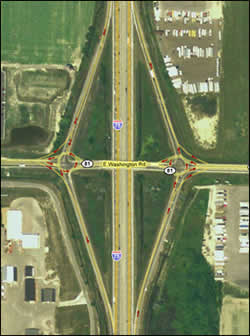FHWA Localized Bottleneck Reduction Program
Case Study
Printable Version [PDF 318KB]
You may need the Adobe® Reader® to view the PDF on this page.
Contact Information: Neil Spiller at Neil.Spiller@dot.gov
 Roundabout Solution at I-75/M-81
Roundabout Solution at I-75/M-81
Location – Saginaw County, Michigan
I 75/M-81 Interchange in Saginaw County, Michigan.
Problem – Heavy truck traffic, inefficient signal operations, and truck overturns
Multiple problems existed at this former tight diamond inter¬change. Operationally, the interchange suffered from heavy truck traffic on the M-81 corridor, inefficient signal control at the ramp terminals, and safety problems as a result of sharp left turns to and from the ramps that contributed to all-too frequent truck overturns. Backups routinely occurred on M-81 as a result. The interchange also included a bridge for M-81 over I 75 that was in "critical condition."
Solution – Construct roundabouts at diamond interchange ramp terminals
Given very limited resources, the Michigan Department of Transportation chose an innovative design approach with roundabouts replacing the signalized tight diamond ramp terminals. The project included reconstruction of the bridge, construction of roundabouts (which included bypass lanes) at the ramp terminals, and removal of the traffic signals. At $5.1 million, this solution represented a cost savings of $6 to 7 million over a typical reconstruction, primarily because right-of-way needs were considerably smaller compared to other proposed alternatives. The interchange reconstruction was completed during CY 2006. Simulation studies have shown that the "roundabout solution" has reduced delays by 58 percent, reduced fuel consumption by 25 percent (which has reduced air pollution emissions), and improved operational level of service from LOS D to LOS A, with no visible traffic back-ups. The roundabout design also provides a much higher degree of safety than the signalized layout, and as designed is much easier for commercial vehicles to traverse. Initial public negativity and skepticism were combated through nonobligatory aesthetic enhancements and educational campaigns, including an editorial rebuttal to a negative article about roundabouts that appeared in the Saginaw News. Ultimately, the initially lukewarm reception of the design concept was replaced by public acceptance and accolades for the completed project.
Lesson Learned
This project demonstrates how an innovative design approach – which often receives initial, dubious reception — can ultimately be realized with constructive public promotion and project message.